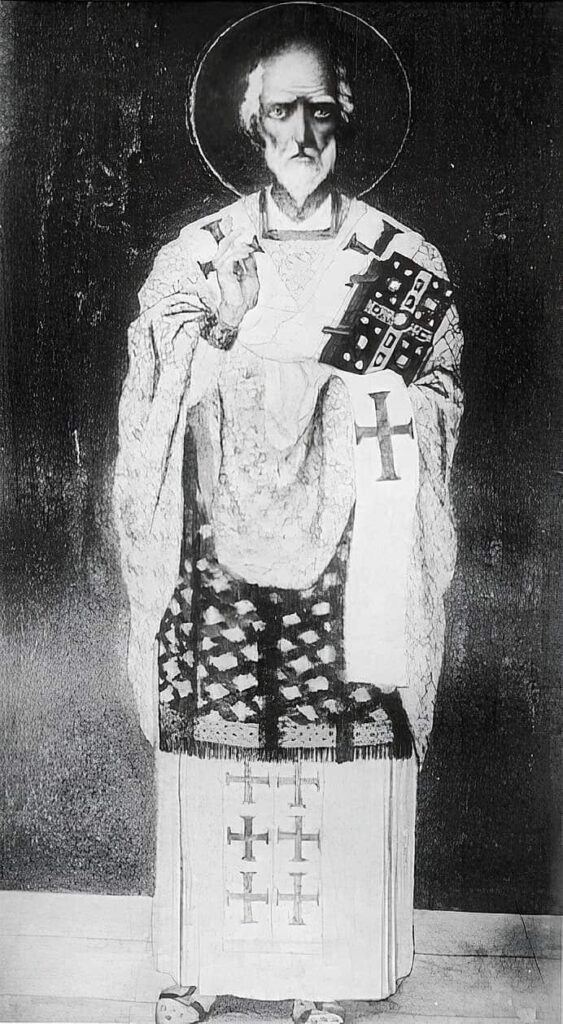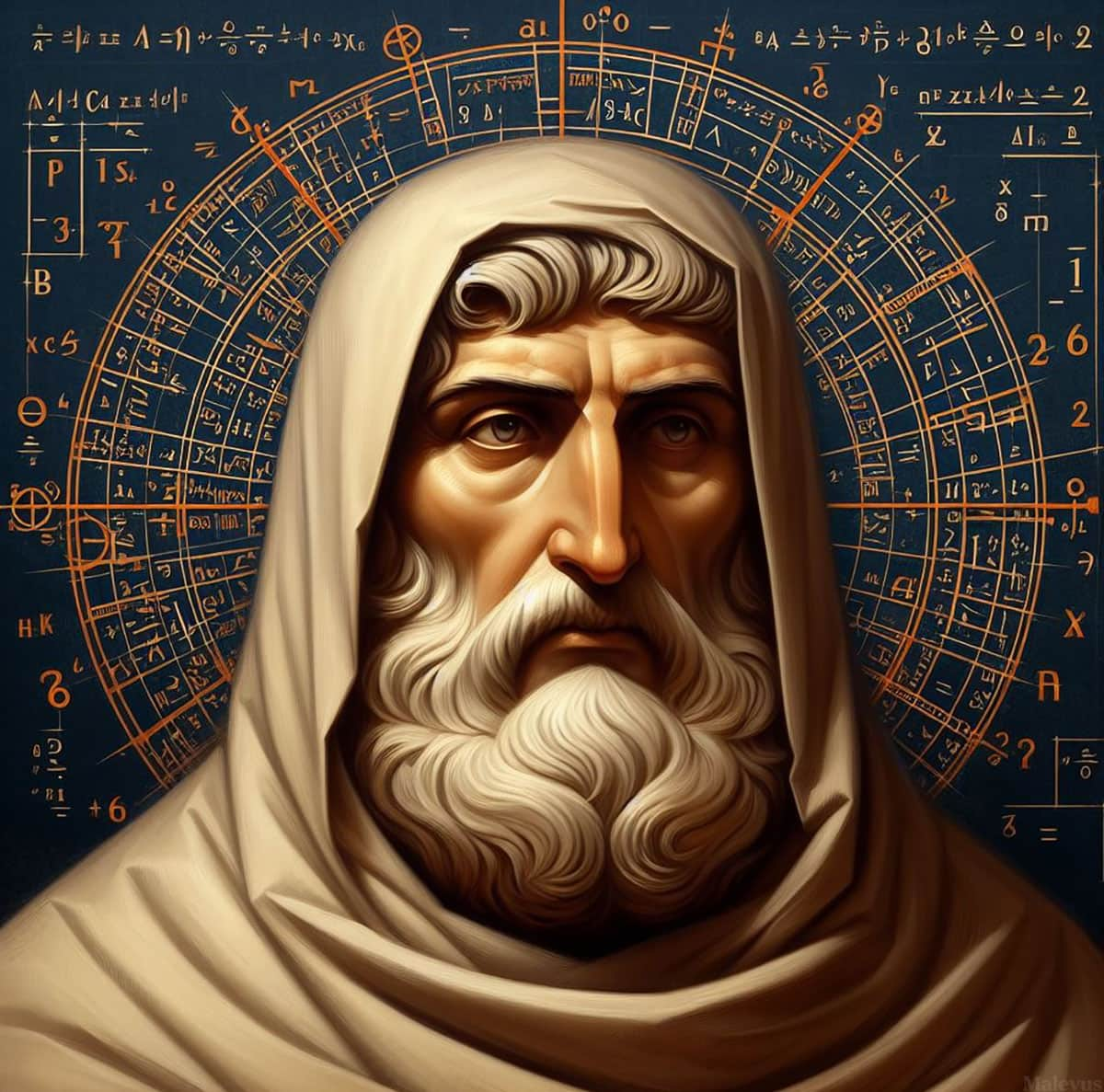Leo the Mathematician (Λέων ό Μαθηματικός) or Leo the Philosopher (Λέων ό Φιλόσοφος) was a Byzantine scholar, philosopher, and religious figure born between 790 and 800, and he died after 869, likely in Constantinople. He served as the Metropolitan Bishop of Thessalonica from 840 to 843. He stood as a logician and philosopher of Byzantine philosophy at the tail end of the Second Byzantine Iconoclasm and the Macedonian Renaissance. Philosophy, mathematics, medicine, science, literature, philology, astronomy, and astrology were all areas in which Leo excelled. In Constantinople, he oversaw the Magnaura School of Philosophy and taught students Aristotelian reasoning. Even though he was an iconoclast, he preached a sermon in support of icons a few months after Emperor Theophilos died.
His only known works are a few comments placed in Plato’s conversation manuscripts.
Biography of Leo the Mathematician
Leo is believed to have been born in Thessaly and was related to John the Grammarian, who was also renowned for his profound knowledge. He pursued studies in Constantinople, where he learned “grammar and prosody,” the disciplines of the trivium. However, he could not find a school in the capital that could satisfy his thirst for knowledge.
He then reportedly traveled to the island of Andros, where an old scholarly monk instructed him in rhetoric, philosophy, and arithmetic. Still dissatisfied, he visited monastery after monastery to consult books in their libraries, and at times, he withdrew to deserted places, immersed in his meditations. He thus acquired expertise in all sciences εἰς ἂκρον, at his fingertips: “philosophy and its sisters, namely arithmetic, geometry, and astronomy, and even music” (the disciplines of the quadrivium).
Upon returning to Constantinople, he opened a school in a private house, where he taught all intellectual disciplines to the sons of wealthy families destined for bureaucratic careers. It is worth noting that if he was the cousin of John the Grammarian, who was also a highly learned individual, the latter had close ties to the emperors since the accession of Leo V the Armenian in 813. In the 820s, John was the tutor to the heir apparent Theophilos, and upon Theophilos’ ascension in 829, he became syncellus and collaborator to the emperor, entrusted with a diplomatic mission to Baghdad around 830. Leo, being John’s cousin, likely had access to the palace during this period.
The Theophanes Continuatus reports a narrative deemed suspicious by historians: one day, one of his former students, whom he had taught geometry and who had become a secretary to a strategist, was captured by the Arabs during a battle. He became a slave at the palace of the Caliph al-Ma’mun in Baghdad and astonished the Caliph and the scholars around him with the extent of his knowledge of geometry. Learning that he owed all his knowledge to Leo, the Caliph sent him back to Constantinople with a letter addressed to his master, inviting him to come and teach in Baghdad.

Leo, out of patriotism or caution, handed the letter to the logothete Theoktistos. Thus, Emperor Theophilos learned that he had a scholar in his capital envied by the Caliph. The Emperor granted him a pension, and his teaching was now done publicly in the Church of the Forty Martyrs. al-Ma’mun persisted and wrote directly to the Emperor, who refused the request. Leo may have still responded to consultations from the Caliph by letter. The details of this story, found only in Byzantine sources, are unclear, but if there is some truth to it, it likely occurred between the ascension of Theophilos in 829 and the death of al-Ma’mun in 833.
Around 840, Leo was appointed Metropolitan Bishop of Thessalonica by Theophilos and John the Grammarian, who had been Patriarch of Constantinople since around 837. He emerged as one of the high-ranking officials of the iconoclastic clergy, although he did not take a known position in this domain. His homily composed for the Annunciation Feast in 842 has been preserved. It is more an exercise in erudition than piety and discusses religious images. In any case, he was deposed in 843, along with John the Grammarian, at the time of the restoration of the veneration of images.
However, he was not nearly as implicated in iconoclasm as John and did not suffer the same damnatio memoriae.
After 843, at an uncertain date, the patrician, and later Caesar Bardas, brother of Empress Theodora and uncle of Emperor Michael III, established a school in the Magnaura Palace (a ceremonial hall in the imperial palace where ambassadors were received). This school served as a setting for the teachings of Leo and other scholars, some of whom were his former disciples. These included Theodore (or Serge), a confirmed disciple specializing in geometry; Theodegios, specializing in arithmetic and astronomy; and Kometas, specializing in grammar.
Leo himself focused on philosophy, covering a range of disciplines. Little is known about the status and operation of this school, particularly whether it was purely a private patronage by Bardas or a more official institution. Around the same time, Photios I of Constantinople, nephew of John the Grammarian and a generation younger than Leo, provided similar education in his private residence. However, while Leo, like John, seemed primarily interested in the mathematical sciences of the quadrivium, Photios was more inclined towards the trivium, a philological and rhetorical culture related to human ethics.
Among the famous students of Leo during this period, which coincided with Photios’ time and during which he himself held a teaching position, was Constantine, known as “the philosopher” (827-869). He is better known by the monastic name Cyril, and, along with his brother Methodius, he left in 863 to evangelize the Slavs in Great Moravia, where he invented the Glagolitic alphabet for them. It may also be worth mentioning Leo Choirosphaktes, who dedicated a funeral epigram to the Mathematician.
This teaching, heavily focused on the scientific legacy of ancient paganism, faced attacks from devout circles. Poems from a former student of Leo named Constantine have been preserved. In one text, he denounces his deceased master as a pagan (wishing him a pleasant stay in Hades with his friends Chrysippus, Socrates, Proclus, Plato, Aristotle, Epicurus, Euclid, Ptolemy, Homer, Hesiod, and Aratus). In another, he apologizes for his ingratitude toward his “second father” but expresses joy in finding a new master, Photios. There is no reason to believe, as some thought, that the author of these poems is Constantine “the philosopher,” who died before Leo.
Leo was still alive in 869, the year he escaped the effects of an earthquake that he had predicted. The year of his death is unknown. He passed into the subsequent generations as “the most eminent man of his time in all kinds of science.” The school in Magnaura, which he had led, also left a lasting impression. His legend was somewhat intertwined with that of Emperor Leo VI the Wise, and the two figures were sometimes confused.
Leo the Mathematician’s Intellectual Activity
Leo has remained, for posterity, the man who, in the first two-thirds of the 9th century, developed and brought to prominence in Byzantium, particularly through research and transcription of forgotten ancient manuscripts, the mathematical sciences (arithmetic, geometry), the astronomy linked to them, and other natural sciences related to medicine. Over time, it seems that his interest, initially focused exclusively on the sciences of calculation and measurement, expanded to more literary and humanistic texts, notably the works of Plato. This evolution perhaps occurred under the influence of his younger contemporary, Photios, who was about twenty years his junior and whose interests were distinctly more literary. We have an epigram from Leo where he pays tribute to Photios and declares himself his student, calling him the “teacher for old men” (γεροντοδιδάσκαλος) in Plato’s “Euthydemus.”
We can gain an understanding of Leo’s original culture by examining the small number of Greek manuscripts that remain from the period around 830-850, containing scientific works. The Vaticanus Graecus 1594, containing the Almagest and other works by Claudius Ptolemy, a manuscript that likely belonged to Leo; the 190 from the same collection, containing Euclid’s Elements and Data, followed by Theon of Alexandria’s commentary on Ptolemy’s Handy Tables; the 204 from the same series, containing a corpus of mathematicians and astronomers (Theodosius, Autolycus, Euclid, Aristarchus, Hypsicles, Eutocius, and Marinus); the Oxford Corpus Christi College 108 manuscript, a collection of biological treatises by Aristotle.
We can also refer to Leo’s epigrams preserved in the Palatine Anthology, expressing his taste for scientific and technical questions. Poem IX, 578 is dedicated to Apollonius of Perga’s Treatise on Conics; IX, 200 focuses on the works of the mechanics Markellos and Kyrinos; IX, 201 is about the astrologer Paulus Alexandrinus; IX, 202 concerns a composite manuscript containing works by Theon of Alexandria and Proclus. These short poems likely served as ex-libris for manuscripts in his possession. He is the author of a few centos also preserved in the Palatine Anthology.
Of Leo’s scientific commentaries, we have preserved a fragment on solar and lunar eclipses, astrological scholia on the ascendant of nativity, and a note on the fifth definition from Book VI of Euclid, transcribed in the margin of a manuscript (Bodleianus d’Orville 301, copied in 888 for Arethas of Caesarea).
Leo is particularly remembered as an astrologer, which was the primary meaning of the Greek word μαθηματικός (Latin mathematicus) in the Middle Ages. Numerous predictions were attributed to him: a good harvest in Thessaloniki; the rise of Basil I the Macedonian; and the earthquake of 869 in Constantinople, which would have allowed him to escape. Moreover, he did not prophesy only through the stars; according to three chroniclers, he saw in the fall of a statue an omen of the assassination of Caesar Bardas. Several astrological writings have been preserved under his name. This trait aligns him with his cousin John the Grammarian, the “patriarch-sorcerer.”
In the framework of philosophy, an epigram (IX, 214 in the Palatine Anthology) attests to Leo’s admiration for Porphyry’s Isagoge, a highly esteemed work in the Middle Ages. But one of his major achievements is his διόρθωσις or revision of the text of Plato’s Laws, the result of which is found in the Parisinus Graecus 1807 manuscript (the oldest manuscript of Plato that has come down to us, containing, in particular, the Republic, Timaeus, and Laws): the work was successfully carried out until Book V, at 743 b, as evidenced by the marginal note “end of Leo the Philosopher’s revision,” which is found in the manuscript and is reproduced in its copies. Par. gr. 1807 belongs to a group of manuscripts created between 850 and 880 by the groups of scholars formed around Leo and Photios.
It mainly includes Plato’s dialogues, commentaries on these dialogues by Proclus, Damascius, and Olympiodorus the Younger, and commentaries on Aristotle by Alexander of Aphrodisias and Simplicius. Since its identification by T. W. Allen in 1893, this group of manuscripts has been called the Philosophical Collection or Platonic Collection. These manuscripts reflect an expansion of curiosity, especially under the influence of Photios, compared to an earlier period of Leo’s focus, aside from Aristotle’s Organon, on mathematicians and astronomers.


